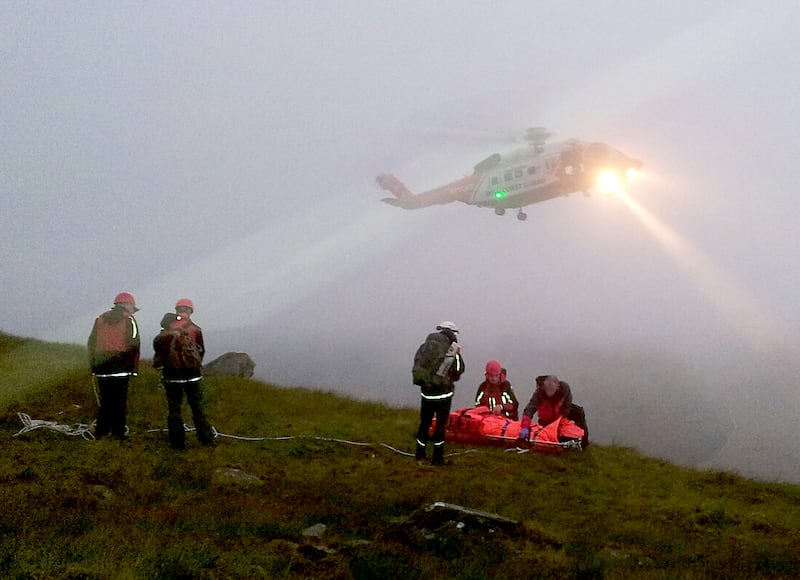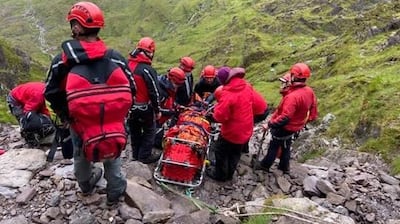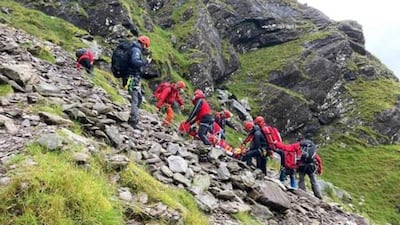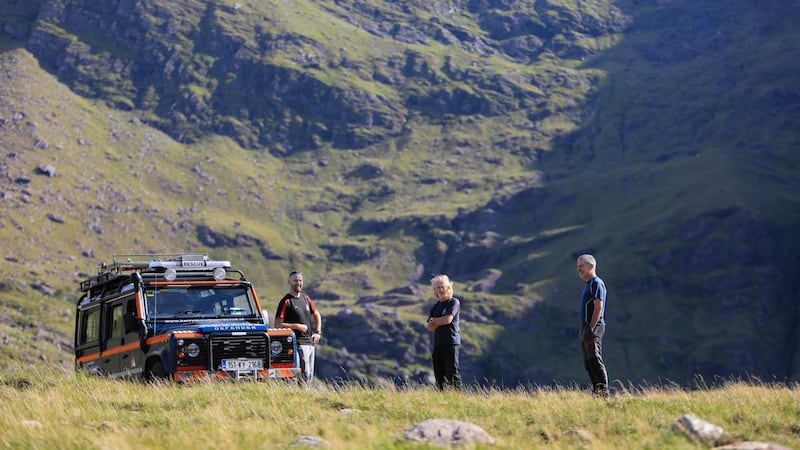Around Corrán Tuathail (or Carrauntoohil) the clouds had taken an each-way bet on a mid-August day. It was sunny in the Hag’s Glen, the valley that leads up to Ireland’s highest mountain (1,040m). A canopy of cloud rested stubbornly on the summit and the top of the Devil’s Ladder, the steep and unstable gully that is the normal route to the top
We came across the accident by chance not far from the summit. A well-equipped climber had stumbled on the descent, suffering fractures which made it serious, given where it had occurred. Other walkers stopped to help. With a stiff breeze and temperatures falling, the priority was to get the casualty off the mountain.
Further down the valley, a big operation was in motion. Four all-terrain vehicles bounced along the rough path deep into the valley, forded the Gaddagh River and stopped at Ard na Locha, about a kilometre shy of the Ladder.

When Kerry Mountain Rescue Team (KMRT) lead co-ordinator Cathal Crudden got the 999 call, he had texted all 35 members of the team. A 26-year veteran, Crudden set up an incident command centre as other team members arrived from all around Co Kerry.
More than 20 volunteers are involved, climbing the mountain in their red jackets and helmets, carrying heavy loads of climbing gear and emergency aid.
“With a serious injury like that,” says Colm Burke, KMRT’s public relations officer, “the first priority is medical attention.” That means the first bags up are for first aid, casualty care, cardiac care, all the first response stuff.
“We do a two-year probation to learn the skills,” says Burke, a member for 10 years. “Everybody on the team will have the full skill set.” That includes first aid and emergency medicinal aid, communications, rope management, even driving the Jeep.
After tending to the casualty, there is a precarious stretcher carry – involving eight members – along steep ground to the top of the Devil’s Ladder. From there, they lower the stretcher on 200 metre cables, with four members of the team abseiling alongside. It takes three abseils to get to the valley floor. Once clear, the casualty is evacuated by rescue helicopter R115. The entire operation takes KMRT six hours. “It was one of those things, it could happen to anybody,” says one of the rescuers.
On the day there were big crowds on the mountain. People were everywhere, trodding like colonies of ants to the cross at the summit.

The numbers climbing have risen dramatically in 2021. It's partly a post-lockdown thing where more people want to do "outdoorsy stuff". But there's also an Instagram dimension. Kerry mountaineer and guide Con Moriarty has seen it: "The Instagram moments are driven by the idea of posing for a picture at the summit cross. It's a type of culture motivated solely by people ticking off things and putting them online."
It has fed into a corresponding increase in call-outs for the service. There have been 51 call outs for Kerry MRT so far this year, more than for all of 2020. The team had an extraordinary 19 callouts in the first 19 days of August.
On Tuesday this week, Crudden, Burke and Gerry Christie, a team member for 20 years, drive into the heart of the Hag's Glen in a Land Rover. It's a glorious day and one of the quietest days in August. For the three, it's the first respite they have had in a month.
Every member of the team is an unpaid volunteer and each callout means dropping work and family to spend between six and 12 hours on the mountain. Crudden says it was becoming unsustainable. “If that had gone on for another week, a lot of our people would have been under a lot of pressure in terms of showing up.”
The situation prompted Burke to send out a “please get serious” plea to people that Corrán Tuathail was not “a walk in the park”. He lists the injuries people had sustained in August alone, including two broken legs, two broken pelvises, six broken ankles, one broken rib, one broken shoulder and two head injuries.

“It goes wrong for the best prepared,” Burke wrote, “but the ill-prepared will always disproportionately feature.” Ill-preparedness typically includes a lack of mountain knowledge, poor clothing/footwear, inadequate food/water, poor fitness and communications.
Last weekend six Irish hikers made headlines when they were benighted on Sweden’s highest mountain, some of them wearing just T-shirts and shorts for the ascent.
The only frisson of annoyance you sense from the volunteers is when they talk of young children being brought into the mountains without adequate preparations. Members have seen kids shivering from cold, fatigued or dehydrated from lack of water.
The other big issue is smart phones. While useful to contact services or locate climbers when lost, on the downside the experience has been that people rely too much on them. "Google Maps is very good for finding Harvey Norman but not so good in telling you which way to get off a mountain in fog," says Christie. On a long day, the battery also dies.
Each region has its own challenges. Croagh Patrick ’s status as a site of pilgrimage mean people routinely climb it who are unfit or in bare feet and and it’s a tough 750m ascent. Over 90 per cent of Mayo MRT’s callouts are to Croagh Patrick, Ireland’s busiest mountain.
“I think people underestimate it,” says Mike Keating of Mayo MRT. “You get people going up in shorts, T-shirts and flip-flops. Other people go up late in the day and it gets wet and cold and they have no water. It turns into an epic.”
For many it will be the only mountain they will ever climb. Amazingly there are relatively few accidents given the numbers. Keating makes a point that all other rescue mountaineers echo in one form or another. “We don’t really like to judge people if they make a mistake or wear the wrong clothes. We are there to rescue them, that is it.”
The two busiest MRTs in the country are those near the capital: Dublin and Wicklow Mountain Rescue (DWMRT) and Glen of Imaal, both with more than 100 callouts in 2020. DWMRT's region includes forest trails near the city as well as the bigger mountains further south. The boom in mountain biking near the capital has become a big factor – with callouts for some major injuries (including one fatality recently). DWMRT has over 70 active members, with the highest level of medical expertise in Ireland or Britain.

“There were a few times this year when we had three callouts in one day,” says Gerry Condon of DWMRT, “which spreads our resources very quickly. We have had 78 call-outs this year so far, which could mean 150 in total this year.” There were 123 in 2020.
Moriarty led Kerry MRT for a decade and describes such organisations as the best example of Irish volunteerism along with the GAA. But he feels that it’s being put under increasing strain by sheer numbers and lack of State support.
“This voluntary model emerged from Kerry in 1966. If it continues like this, and you don’t need to be a great seer, something will have to give. Mountains have become the extension of the urban playground. It’s putting enormous pressure on this great element of volunteerism in society.”
Moriarty is in a direct line of eight generations of mountain guides going back to 1790. The first acknowledged guide, Cornelius Moriarty (1808-1865) was his great-great grandfather. He is the greatest authority on Corrán Tuathail, its history, its environment and heritage.
Loath though he is to say it, Moriarty believes one long-term solution is unavoidable: a “sacrificial track” to the summit, a safe walkable route to the top.
“The Scottish realised they had to put a track up Ben Nevis. Nobody wanted to see it. But from a conservation point of view, it made sense. Corrán Tuathail needs a track, although I don’t think I will see it in my lifetime,” he says.
For Moriarty, the State has marketed the mountains assertively but not matched it with resources, infrastructure, planning or vision. Many don’t have adequate parking or toilet blocks at the trailhead. There are no safety campaigns like there are for road safety or water safety. For him it’s an abdication. It’s all left to voluntary rescue teams who have to raise funds to provide part of their services. Still, all would say it should remain voluntary. They do it because they love the mountains, the social purpose, the camaraderie, deploying the skillset, and the teamwork.

A woman recently injured on Croagh Patrick summed it up in a heartfelt message to Mayo MRT which she posted online. “We are hugely grateful... These are our unsung heroes who give their time to others.”
What you need to mountaineer safely:
– If it's your first time, go with experienced walkers or a guide.
– Wear proper clothing: No jeans, no cotton, as they get wet and stay wet.
– No footwear without treads.
– Bring layers to add/remove, hat, gloves and waterproof jacket for everyone.
– Adequate food and water. Energy bars
– Fully charged mobile phone. Don't over-rely on it.
– A map and compass. Learn how to use them.
– A whistle. Rescue signal is six long blasts, repeated.
– A head torch.
– A small first-aid kit.
– A Kishu (lightweight tent-like shelter) for bigger mountains.
Ruth Cunniffe, spokesperson for Mountain Rescue Ireland, which represents all 11 MRTs and 400 trained volunteers, adds:
– Know your route.
– Tell somebody where you are going and when you expect to be back.
–Very importantly, check the weather as it is very changeable in Ireland.
– If there is a weather warning, reconsider the walk.











